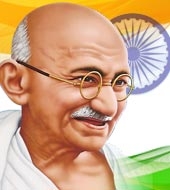
From being an advocate to a freedom fighter, the legacy of Mohandas Karamchand Gandhi is nothing short of extraordinary. History remembers him as the man whose unflinching courage and persistence shook the British to the core. His message of peace, forgiveness, tolerance and freedom has never been more relevant than today. Let us take a walk in the shoes of the Mahatma who gave the world the gift of Ahimsa.
On 8th August 1942. Mohandas Karamchand Gandhi addressed the masses from the Gwalior tank maidan in Bombay (now) Mumbai), during a historic session of the All India Congress Committee (AICC). This marked the beginning of Bharat Chhodo Andolan or the Quit India movement.
Cooperation and World War II By 1939, events from other countries had begun to find their resonance in India. The Second World War had broken out and the Indian leaders fully sympathised with the victims of fascist forces. But an enslaved nation could not be drawn into the war.
Britain was pressured by the Allied forces (U.S., USSR and China) to exert its influence and seek Indian cooperation in their war efforts. Upon negotiation, the Indian political leaders agreed to comply. but only if they were guaranteed a complete transfer of power and independence in exchange.
On 8 August 1942, unable to reach a consensus with the imperialists, India’s freedom movement headed towards its tumultuous final campaign. The Quit India Movement (also known as August Kranti) saw Gandhiji motivate the populous “to do or die” until the British quit India.
The Britishers ruthless response to this was imprisonment without trial. The entire Congress leadership including Gandhiji was arrested the following morning.
But the fight for liberation continued. The masses took to the streets to protest against the colonisers brutality By now, the freedom movement had inculcated a dominant feeling of oneness in the heart of the average Indian and a unique unity in diversity prevailed.
What followed was the entire country invigorated by the spirit of nationlism looking forward to end of colonial rule with a sense of urgency.
Unity in diversity
“I believe that in the history of the world, there has not been a more genuinely democratic struggle for freedom than ours…Once you realise this you will forget the differences between the Hindus and Muslims. and think of yourselves as Indians only, engaged in the common struggle for independence” (excerpt from the Quit India speech)
The Muslim League led by a Bombay based barrister Mohammad Ali Jinnah propagated the theory that Hindus and Muslims belonged to two different Nations
Gandhiji opposed this idea vehemently. For him, secularism was the foundation of India’s freedom movement. He quoted that since ancient times our people have always been sensitive to the fact that the welfare of a society depended on a consensual and accommodative intercommunity network. According to him one’s identity is never solely bound to the religion he or she subscribes to.
The power of ahimsa
7 and my Ahimsa are on our trail today in the present crisis, when the earth is being scorched by the flames of Himsa and crying for deliverance” (Excerpt from the Quit India speech)
Many scholars have drawn a parallel between Gandhiji’s practice of ahimsa and the Christian ideology of tuming the other cheek. Historian Mridula Mukherjee looking back at Gandhiji’s attempts to put an end to the 1947 Calcutta riots, suggests that his willingness to suffer for the sake of humanity had a tremendous moral appeal that inspired devotion in his followers.
Gandhiji’s non-violence was conscious suffering of the flesh that demanded universal love and supported his vision of a free India Author Arundhati Roy calls Ahimsa India’s greatest gift to the world.
The mantra
“Here is a mantra, a short one, that I give you. You may imprint it on your hearts and let every breath of yours give expression to it. The mantra is: Do or Die. We shall either free India or die in the attempt we shall not live to see the perpetuation of our slavery.. “(excerpt from the Quit India speech) Gandhiji’s clarion call “Karo ya Maro”, “Do or die” set in motion a series of events that finally ended the British Raj in India.
Did you know?
- The iconic ‘Quit India’ slogan was coined by socialist Congress leader and lesser-known hero of the Indian National movement Yusuf Meher Ali in 1942.
- Historians suggest that the title of Mahatma was bestowed on Gandhiji by Rabindranath Tagore.
- The title of Father of the Nation was given to the Mahatma by Netaji Subhas Chandra Bose.
- Gandhiji was nominated for the Nobel Peace Prize five times but was never bestowed with the honour.
- 0 Gandhiji’s birthday (2nd October) is commemorated worldwide as International Day of Non-Violence.
- 30th January the day Gandhiji was assassinated is observed as Martyrs Day or Shaheed Diwas, in India.
Picture Credit : Google



